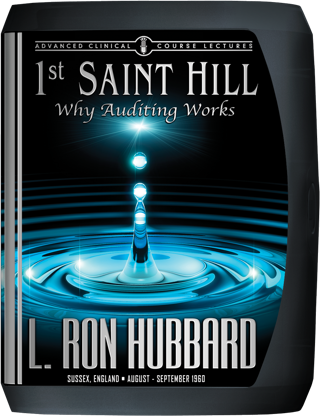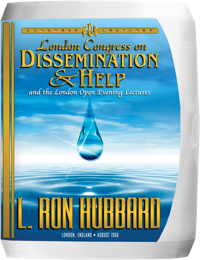- 繁體中文 | Chinese
- Dansk | Danish
- Deutsch | German
- English | English
- Ελληνικά | Greek
- Español (Latino) | Spanish
- Español (Castellano) | Castilian
- Français | French
- עברית | Hebrew
- Italiano | Italian
- 日本語 | Japanese
- Magyar | Hungarian
- Nederlands | Dutch
- Norsk | Norwegian
- Português | Portuguese
- Русский | Russian
- Svenska | Swedish
Publisher of New York Times and International Bestselling Author L. Ron Hubbard
1st Saint Hill ACC
Why Auditing Works

1st Saint Hill ACC
Why Auditing Works
From L. Ron Hubbard’s discovery of the four factors requisite to any auditing session—Help, Control, Communication and Interest—came a new era of case gain extending up from the bottom of The Bridge. Known as the Deadly Quartet, these factors furnished both the means to eliminate the barriers to case advance and a powerful dissemination tool. Before Interest can awaken, the other three factors must be addressed, and in particular that greatest ability of the human race and make‑break point of a being—Help. After demonstrating the Deadly Quartet in the London Congress on Dissemination & Help, Mr. Hubbard provided the technology for starting a preclear upward with Presessioning, the processes and procedures to get anyone in session: willing to be helped, under the control of an auditor, in communication and interested in own case. Moreover, here is his first fully embracive statement on auditor presence and altitude—essential factors enabling the preclear to confront his case, and bringing into practical reality the auditing maxim: Auditor plus pc is greater than bank. As Mr. Hubbard’s only ACC at Saint Hill, this is where he codified modern auditing. It therefore stands as his premier ACC for all auditors.
Read MoreMore About 1st Saint Hill ACC
Program number 1 for the United Kingdom starts at 7:30 tomorrow morning at the Charing Cross–Embankment Underground where the bus leaves for Saint Hill. That’s when that program starts. —L. Ron Hubbard
That program, as announced to attendees of the London Congress on Dissemination & Help, would span the next four weeks and encompass twenty-five L. Ron Hubbard lectures. It further would go down in Scientology history as the start of a new era of case gain—extending from the very bottom of The Bridge.
All unfolded from Mr. Hubbard’s early 1960 discovery of four factors requisite to any auditing session. Which is to say, these are factors which, if omitted, prevented any session from taking place at all. Hence, here were the components defining the term “in session” with a practical thoroughness that had never before been achieved. These factors—Help, Control, Communication and Interest—soon became colloquially known amongst Saint Hill auditors as the “Deadly Quartet,” owing to their telling impact on the barriers to case advance.
Indeed, so pervasive were these factors that they even addressed and handled the reasons why a person who had never heard of Scientology was not in session, thus bringing a new and powerful tool to the cause of dissemination.
So it was, on August 8, that bus rolled onto the Saint Hill grounds bearing the students who would now vanguard this new era. Over that next month, they were to hear lectures truly monumental in scope. These, in fact, are his first fully embracive statement on auditor presence and altitude—essential factors by which an auditor gets the preclear to confront his case, thus bringing into practical reality one of the oldest auditing maxims: Auditor plus pc is greater than bank.
Here, too, is the full technology of Presessioning, the processes and procedures to get anyone fully in session—that is, willing to be helped, in the control of an auditor, in communication and interested in own case. While, in what amounted to Mr. Hubbard’s overriding datum, he spoke of the ability to help as the greatest of human abilities. And, the destructive power of a being’s own failures to help.
And were that not enough, he detailed a host of other fundamentals:
- Auditor Requirements—why one not only has to know how to do a rote procedure, but must understand what is going on in a session;
- Skill in Auditing—the ease and smoothness of handling a preclear while auditing directly monitors the degree of concentration he can put upon his case;
- Help—why it is the greatest ability of the human race;
- Failure to Help—why it is the main background and fundamental and core of a pc’s case;
- Havingness—the reasons one opens a case with it, the difference between Subjective and Objective Havingness and why Objective Havingness changes the profile or prepares a case;
- Paralleling the Mind—what it is and how it is done in auditing;
- Security Checking—underlying theory of why it is used to get a preclear’s case in shape;
- Assessment—if a terminal is precisely assessed it will rise and fall when running. No change of Tone Arm means the auditor is not processing the right terminal;
- Confidence in the Auditor—the more confidence the pc has in the auditor, the steeper the rises and falls of the Tone Arm;
- Other-determinism—the most elementary mechanic of auditing is that other-determinism is furnished and tends to run out some of the other-determinism on the pc’s bank just by the auditor sitting there. The auditor could go through the motions of auditing and something would happen to the case, even without running a process;
- Atomic Fission—the only reason a person is afraid of atomic fission is that it develops tremendous motion;
- Motion—why, when a process on motion is run, withholds start stripping off.
Finally, and to cap it, Mr. Hubbard presented Theory 67, a breakthrough on the Sixth and Seventh Dynamics providing new insight into beingness, havingness and why a thetan introverts into the mest universe.
Here, then, is the historic 1st Saint Hill Advanced Clinical Course, signaling the dawn of what L. Ron Hubbard called “the jet age of Scientology.”
